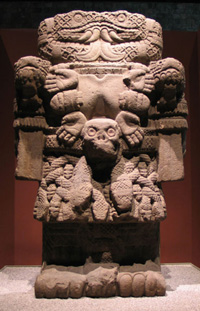|
The Great Mother(continued) By Tala Bar The Mother Goddess, however, as a result of her being in control of all life on Earth, has also an opposite character to her birthing and nurturing aspect, and that is the end of life, which is death. As a ruler of the seasons of the year, she is in charge of Spring, which is the time of birth and growth; Summer, the season of maturity and fruition; and Winter, which is the time for dying. But the latter leads up to the renewal of the cycle, and to new revival in spring. This double aspect of the Mother as ruling both birth and death is also expressed in the psychological idea of regarding the real mother with the ambivalent feeling of both love and hate. As such, some mothers have been portrayed as monsters. Such, for instance, is the Aztec Birth goddess Coatlicue who, according to the Wikipedia, was "Mother Goddess of the Earth who gives birth to all celestial things", but also "Goddess of Life, Death and Rebirth." This goddess is represented as wearing "a skirt of snakes and a necklace made of human hearts, hands and skulls". She also digs graves for the children she kills, as well as purifies them. It is said that "Most Aztec artistic representations of her emphasize her deadly side, because Earth, as well as a loving mother, is the insatiable monster that consumes everything that lives" (and dies, I should add). "She represents the devouring mother, in whom both the womb and the grave exist." Now, one special child who dies and is reborn to his Earth Mother is the young god who represents his people, the subjects of their own particular Mother Goddess. Such mother-child relationships are well known in the myths of Mesopotamian Ishtar and Tamuz; Phrygian Cybele and Atis; Greek Semele and Dionysus; Egyptian Isis and Osiris/Horus; and Canaanite Anat and Baal/Mot. (Although Anat is said to be the brothers' sister, daughter of the Mother Goddess Athrat, she is in character much more than a junior figure, assuming in many cases the function of a Mother). In the Navajo myth, as told in the Encyclopedia of World Mythology (p. 77): "Changing Woman is an Earth Mother figure, ageing with the seasons, who is restored to girlhood each spring. From her union with the Sun ... spring the Twins, hero figures and models of virile warriors. Changing Woman was the Creator who gave life to First Man and First Woman, and taught them all their wisdom and lore." The Christians know such deities as Mary and Jesus. As Mother Nature, the Goddess, then, rules over the cycle of life on Earth, which includes birth, growth, copulation, death and burial. The Son born to this Goddess, who is a leader of her believers, symbolizes this cycle with his own life; sometimes, he is ritualistically sacrificed to her, in order to be reborn and to symbolize the eternal continuation of the cycle. But, as plants die and vanish into the bowels of the Earth and are being revived, come out and grow again the next season, thus the Mother Goddess' Son is expected to be reborn again after being dead and buried in the Earth. This is the eternal cycle of life and death from which no living being can escape. Only the developing of this sacrificial god into a reigning Sky god could have broken the cycle and the power of the Great Mother, as happened in many human cultures. In real life, the mother, who is regarded by her children as nurturing and loving, may also be regarded as ruling and controlling; against this control of their lives, as well as from the eternal cycle, men must have always rebelled in order to escape. This rebellion, as it is expressed in mythology, can sometimes take a form of hostility and alienation. A typical story that expresses this situation is the Babylonian myth of the Water Mother Goddess Tiamat (s. above) and her son Mardukh, who killed her and dissected her body, from which he supposedly created the Earth. It may be seen that, unlike the Father God "who art in Heaven", which is a remote, abstract entity, Mother Earth is a concrete, visible body, from which all life has sprang and without which we would not know how to exist. She is the Mother of us all, without whom there would be no life on earth. It must be acknowledged that this Mother Goddess is our World, and a revolt against her is a revolt against the world as we know it. It is possible that such a revolt is part of human nature, which tends to aspire to heights and would not be a prisoner in the bondage of Earth. Such a revolt carries with it the danger of destroying what is the only human habitat yet known in the universe.
Encyclopedia of World Mythology Links: Mother Goddesses
of the World
|
